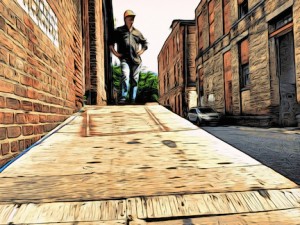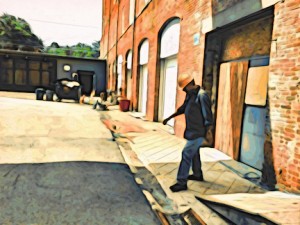Ramps get more useful in higher gravity.
You’re probably wondering what kind of nonsense I’m going on about now, aren’t you? “McCoy,” you’re saying, “that diet your wife has you on has driven you straight around the bend, hasn’t it?”
Well, it hasn’t. At least not mostly. Hardly any, really.
 Anyhow, ramps at different gravity levels: generally speaking, they’re much more useful at the higher ones. If you’re in zero g, just floating around, a ramp is going to be pretty pointless. As gravity gets higher, though, more and more solutions for bridging vertical distances (or, as I prefer to call it, going up and down) become infeasible.
Anyhow, ramps at different gravity levels: generally speaking, they’re much more useful at the higher ones. If you’re in zero g, just floating around, a ramp is going to be pretty pointless. As gravity gets higher, though, more and more solutions for bridging vertical distances (or, as I prefer to call it, going up and down) become infeasible.
Elevators, for instance, become useless really fast. Materials technology just isn’t able yet to create a material that can maintain the tensile strength necessary for lifts, elevators, etc. Same thing for pulleys and lifts. Building a high gravity ramp, though, doesn’t require expensive, crazy space materials—it requires dirt. Just dirt. Good old fashioned, boring dirt. Just start piling it up, and there you go.
 As far as I know, there’s only one book where a ramp saves the day, and that’s Mission of Gravity, by Hal Clement. It takes place on this weird planet with enormous gravity that actually changes between the poles and the equator. It’s weird, but the math works out. Anyhow, these little centipede aliens who live there are hired to retrieve a human probe near one pole, where the gravity is highest, and they end up using a ramp to retrieve the probe’s computer at the end. My oldest son found it for me, back in the kids’ rocket-ship-loving days. Not much of a reader, but I liked that book well enough.
As far as I know, there’s only one book where a ramp saves the day, and that’s Mission of Gravity, by Hal Clement. It takes place on this weird planet with enormous gravity that actually changes between the poles and the equator. It’s weird, but the math works out. Anyhow, these little centipede aliens who live there are hired to retrieve a human probe near one pole, where the gravity is highest, and they end up using a ramp to retrieve the probe’s computer at the end. My oldest son found it for me, back in the kids’ rocket-ship-loving days. Not much of a reader, but I liked that book well enough.
“McCoy,” you ask, “that’s all fine and dandy, but it doesn’t actually answer my question. Are you thinking about heavy gravity because the diet’s working and you’ve lost weight? Or have you been cheating on the diet and actually gaining weight?”
Well, let’s just say Maggie wasn’t happy when she found me taking apart our scale to try and gimmick it to read my weight lower than it is.
 the TV. I can’t say as I’m a huge fan now, but I can definitely see the appeal. (Except for robots. We’ve already lost enough jobs to them; manufacturing lines hardly even need people anymore.)
the TV. I can’t say as I’m a huge fan now, but I can definitely see the appeal. (Except for robots. We’ve already lost enough jobs to them; manufacturing lines hardly even need people anymore.) I don’t know how much power teleporters use, but I feel like it can’t be cheap to run one. Plus, the teleporters come out in those nice, carpeted rooms. They can’t possibly load all their stuff from there. There’d be marks all over the carpet.
I don’t know how much power teleporters use, but I feel like it can’t be cheap to run one. Plus, the teleporters come out in those nice, carpeted rooms. They can’t possibly load all their stuff from there. There’d be marks all over the carpet.

 The Aztecs were real tricky to find stuff on. Almost every supposed “source” detailing its construction techniques immediately starts going on about how they sacrificed people during construction, then doesn’t bother to actually discuss the techniques they used. I’m no trained historian, but that seems like sensationalism to me, and it sure doesn’t answer my questions.
The Aztecs were real tricky to find stuff on. Almost every supposed “source” detailing its construction techniques immediately starts going on about how they sacrificed people during construction, then doesn’t bother to actually discuss the techniques they used. I’m no trained historian, but that seems like sensationalism to me, and it sure doesn’t answer my questions. The Incans were the easiest to find information on, since most of the stuff on the Internet is about their construction techniques anyhow. Their buildings were famed for being constructed of huge stone blocks in irregular patterns that for together perfectly, without gaps. You can’t even stick a knife between the stones.
The Incans were the easiest to find information on, since most of the stuff on the Internet is about their construction techniques anyhow. Their buildings were famed for being constructed of huge stone blocks in irregular patterns that for together perfectly, without gaps. You can’t even stick a knife between the stones. I had a brand new Schwinn, and he had one of those heavy black Raleigh bikes from England. The boards were resting on the cinder block at about a 45-degree angle. I went first, on account of John being quite a bit smarter than me. I moved right up against his house to get the fastest start I could. I came at the ramp straight on and made it onto the board I was aiming at, which then promptly broke in half, and I crashed full speed into the cinder blocks.
I had a brand new Schwinn, and he had one of those heavy black Raleigh bikes from England. The boards were resting on the cinder block at about a 45-degree angle. I went first, on account of John being quite a bit smarter than me. I moved right up against his house to get the fastest start I could. I came at the ramp straight on and made it onto the board I was aiming at, which then promptly broke in half, and I crashed full speed into the cinder blocks. John, meanwhile, hadn’t bothered to watch me go down. When he saw me ramp, he just had to go himself. He used a different, longer board than I did. As soon as his back wheel hit the end of the board, it flipped up into the air like it were part of a catapult, flew through the air, and somehow managed to land on one end on my injured arm between the wrist and elbow, breaking it a second time before bouncing farther down the hill.
John, meanwhile, hadn’t bothered to watch me go down. When he saw me ramp, he just had to go himself. He used a different, longer board than I did. As soon as his back wheel hit the end of the board, it flipped up into the air like it were part of a catapult, flew through the air, and somehow managed to land on one end on my injured arm between the wrist and elbow, breaking it a second time before bouncing farther down the hill.